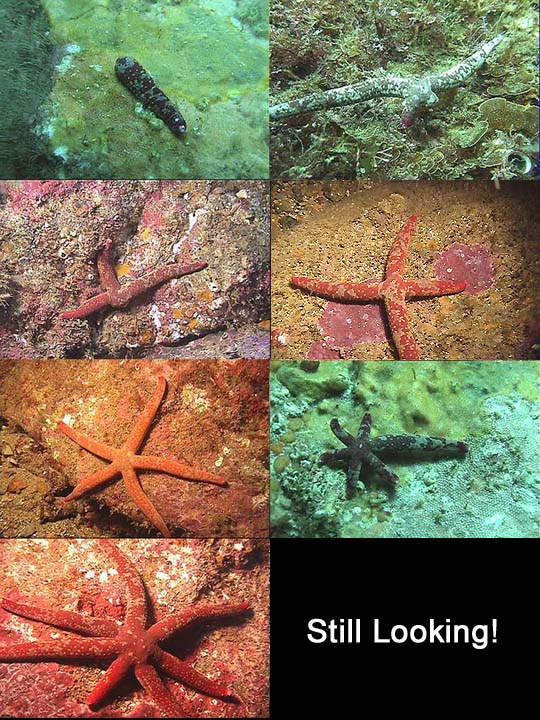

We all learned back in high school biology that starfish have five "arms." Well, there are a few species in our area that must have been schooled in the "new math." One example is the variable or fragile star which "normally" has five arms, but may possess one to nine of them. To date I have only seen individuals with up to seven arms, but I'm still searching. I guess it is kind of like looking for the four-leaf clover!
This starfish is a southern species, found from Pt. Conception to Columbia and the Galapagos on rocks in depths up to about 250 feet. It is reported to reach a diameter of 4" but I have seen larger individuals in our Dive Park. Their coloration is mottled with shades of red, orange and gray dominating. Because red light is eliminated at relatively shallow depths due to absorption by water, the reds and oranges often appear dark gray or black. Therefore these starfish may be hard to spot as they crawl along the rocks. When a dive or video light is focused on them, the bright reds and oranges make them easy to spot.
Most starfish are predators, feeding on mussels and other bivalves, snails or even other starfish. Not much is known about the diet of the fragile star. It is believed to secrete mucus which traps bacteria and organic matter. Yummy.
The arms are rarely the same length since the fragile star is capable of breaking off (autotomizing) an arm when threatened. Fish or other predators may then attack the loose arm allowing the animal to escape. More commonly this process is used to reproduce asexually since the arm cast off may grow into a new individual in about three years even if it lacks a portion of the central disc. This is somewhat unusual in starfish. Arm loss appears to peak in late summer although it occurs throughout the year. Even one single individual can establish a new population this way. An interesting reproductive process but I think I prefer a more conventional approach!
Fragile stars are male or female and can reproduce sexually like their relatives. The sperm and eggs are cast into the water and develop into larvae that can drift in the plankton briefly. In Catalina waters females seem to outnumber males (I should be so lucky). This species produces low numbers of sperm and eggs compared to its other relatives. Individuals which have lost arms may not produce sperm and eggs at all because most of their energy is dedicated to regenerating the lost arm(s). In one study near Catalina's Isthmus, 60-80% of the fragile stars had lost at least one arm. There was little evidence in the adjacent waters of larval forms that might have dispersed to new locations with the currents.
Many years ago I spoke with the USC researcher who conducted this study. She was interested in why they are so common in Catalina waters given the deep channel and "long" distance between here and the mainland relative to their limited dispersal as planktonic larvae. I suggested that adults may have arrived at Catalina on drifting kelp holdfasts. In my research I have often collected them this way. "Rafting" on drifting kelp holdfasts almost ensures successful colonization since it brings adult individuals which are already reproductive. Even a single fragile star could begin a new population since it can reproduce by autotomy.
Even a nine-armed fragile star pales in comparison to its relatives the sunflower stars which may have 25 arms or more. Imagine trying to coordinate that many appendages as you crawl home. I think the fragile star was wise to stop at nine. I have enough trouble with just two (I haven't crawled since I was a baby)!
© 2003 Dr. Bill Bushing. Watch the "Dive Dry with Dr. Bill" underwater videos on Catalina Cable TV channel 49, 10:00 AM and 5:00 PM weekdays.

Image caption: Variable or fragile stars in the Casino
Dive Park with one to seven arms
This document maintained by
Dr. Bill Bushing.
Material
© 2003 Star Thrower Educational Multimedia